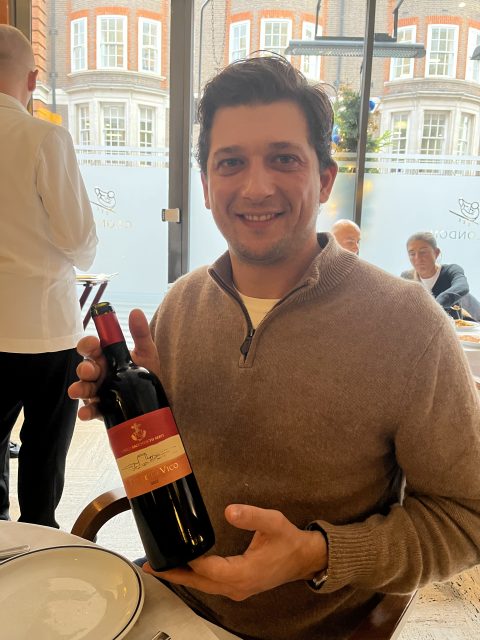This website uses cookies so that we can provide you with the best user experience possible. Cookie information is stored in your browser and performs functions such as recognising you when you return to our website and helping our team to understand which sections of the website you find most interesting and useful.
Castello di Vicarello: a fresh take on Tuscan red wine
Castello di Vicarello winemaker Brando Baccheschi Berti tells db about his pursuit of a fresher style of Tuscan wine, and the challenges presented by Brexit and climate change.

Previously a keen sailor who came close to representing Italy at the Olympics, Baccheschi Berti swapped the high seas for the rural idyll of Poggi del Sasso, in Maremma, when he re-joined the family business in 2013. In 2015, he fully took over operations in the vineyards, winery and cellar from his father, Carlo.
While the estate is in the DOC of Montecucco, Baccheschi Berti explained that he doesn’t use it on the label because of its limited brand power and the limits it imposes on his winemaking: “I don’t like the rules there. As a DOC, it is weak because we are squeezed by the giant of Montalcino.” Instead, the wines are designated under the Toscana Indicazione Geografica Tipica (IGT).
Merah 2019, which retails for around €30, is 100% Sangiovese. After a first ferment in stainless steel, half is then matured in French oak (35 hectolitres) and half in stainless steel. Baccheschi Berti explained: “We don’t use wooden barrels for the flavour, but for the roundness. The stainless steel preserves freshness, so that it is not aggressive in the mouth.” The name means ‘red’ in Indonesian, a reference to the family’s background in Bali.
The result is indeed fresh and easy to drink. As for pairings, he said: “This wine is the kind of wine you can have a glass by itself…or even, when you slightly chill it, with fish.”
With Terre di Vico 2015 (RRP: €52), Baccheschi Berti explained: “We go up with body, intensity and structure”. Before he took over, the blend was 70% Sangiovese and 30% Merlot, but he “updated” it to 65% Sangiovese, 25% Merlot and 10% Cabernet Franc in order to modernise it, and give it some of his personality. It was aged in French oak for 12 to 18 months, and then aged in bottle for the same.
“Nowadays,” Baccheschi Berti argued, “you can have the most sophisticated, complex wine, but you need freshness and roundness. We all appreciate the old opulence, but now you don’t want to open a bottle and struggle to finish it.”
From 2015, a vintage he described as “slightly warm, but very good”, the wine bearing the name of the estate, Castello di Vicarello, was also tasted (RRP: €88). A blend of 45% Cabernet Franc, 45% Cabernet Sauvignon and 10% Petit Verdot, it was aged in 2.25hl French oak barrels for two years and then in bottle for a further two. The Petit Verdot “brings character – it is very aromatic, if you don’t treat it in the right way it can stab you in the back.”
On the nose, he summarised the profile as: “blackberries, star anise, cardamom, tomato leaf, tobacco and leather”. On the palate, he called it: “a meditation wine…you want it with a three-course dinner”.
To sell a wine it takes more than just what is in the bottle to catch the attention of consumers. When asked if there was a particularly reason for the colourful label designs, he said: “We love Rothko!”

From January there will be a fourth red added to the line-up, 2019 Poggio Vico, Made from 100% Malbec, the emphasis will, again, be on freshness: “It only took us 17 years to get to the right point to make it!” The estate already produces a rosé (but “not enough” to export) and there are long-term plans to produce a “long-ageing” white wine, though the vines have not been planted yet.
Perhaps the more immediate concern is the vintage just gone, one characterised by extreme drought: “I’m very happy about how it [the 2022 vintage] ended. I was very sceptical, because of the lack rain. But, because we grow our vines at a super-high density, 9,000-14,000 plants per hectare, the roots compete and they go deeper to find water, they were not too stressed.” Even so, a 22-25% dip in production from the annual average of 25,000 bottles is expected.
“It is now extremely difficult to make wines below 13.2%, 13.3% ABV. I hope it [global warming] will become better again: climate change is real, it’s here, and we’re noticing it.” However, Baccheschi Berti was still optimistic that the winery would be able to adapt and reach its targeted production of 45,000 bottles per annum within the next decade.
The wines, via distributor FortyFive10°, have a significant UK presence, being found in numerous merchants, restaurants and bars, including actor Idris Elba’s Porte Noire. But, of course, there is the elephant in the room when it comes to getting European wines to the UK market. While Brexit has “luckily” not presented too many issues for getting Castello di Vicarello’s wines onto the UK market, there have still been difficulties: “The first shipment we made took just nine days to reach the importer. The one after took one and a half months, the one after that took two weeks. The big issue comes as soon as it hits UK Customs.”
With these obstacles, both bureaucratic and climatic, Baccheschi Berti acknowledged that running the business is not always plane sailing, but he was fully confident for the future, and the company’s trajectory: “The number of wine connoisseurs is growing, our brand is getting better known every year.”
In the summer, db spoke with Giovanni Mazzei about his all-Sangiovese Chianti Classico Gran Selezione Ipsus.

